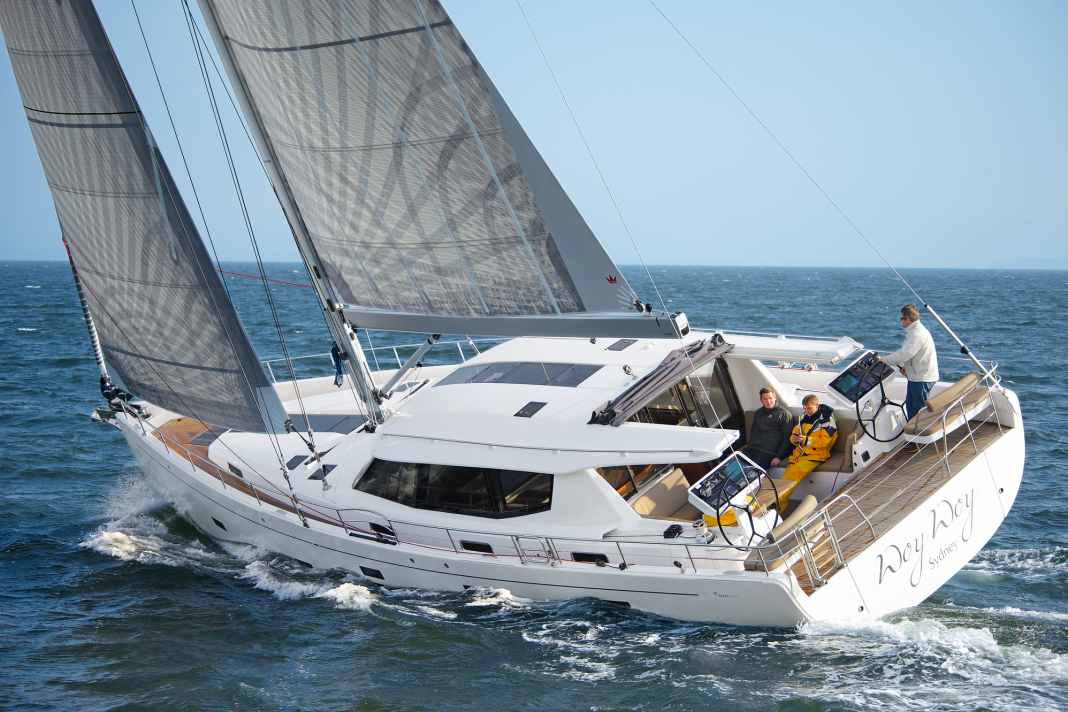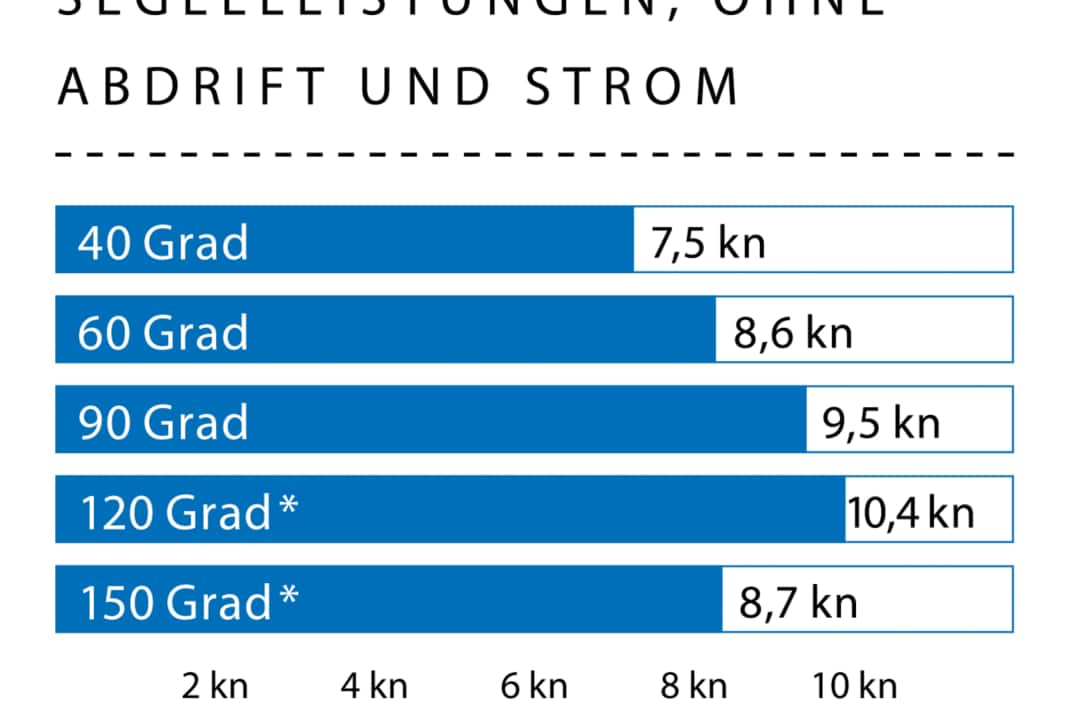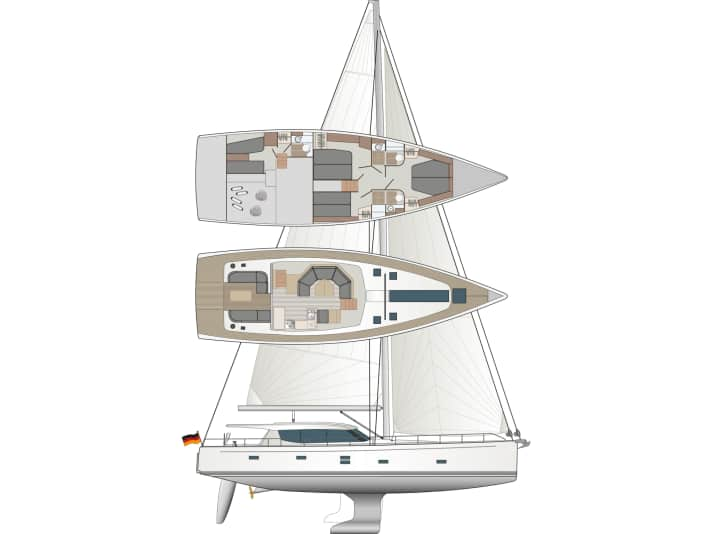





An unpleasantly stiff breeze whistles across the Greifswald Bodden from the north-east. At the helm of the Moody DS 54 it is getting very cold. "You can manage on your own here, can't you?" Hanse's marketing man takes his leave in the lee behind the cabin house. In the well-protected cockpit, there is almost no sign of the biting wind. The temptation to follow him and simply let the autopilot do the work at the draughty helm is great. However, steering a stately yacht like the Moody DS 54 in such beautiful windy conditions is surprisingly fun, but you can also freeze a little.
The Moody brand originally comes from England. The shipyard has built up a good reputation with comfortable, blue-water-capable and high-quality sailing yachts. Following economic difficulties, the traditional company was taken over by Hanseyachts AG in 2007 and production was relocated to Greifswald in Germany. Shortly afterwards, the yacht builders caused a stir on the market with a very avant-garde-looking ship concept.
Upscale luxury in a large format:
The Moody DS 45 presented itself in a design that was both daring and visually very unusual. The idea of Hanse's in-house designer Bill Dixon: a mixture of monohull and catamaran with a combination of all the advantages of both concepts - the best of both worlds.
The special feature of the unconventional plan: The cockpit and saloon with galley and navigation are on one level, separated by a wide sliding glass door, just like most conventional cruising catamarans. The actual living area with the cabins and heads compartments, on the other hand, is recessed. This means that the interior is arranged on two levels, a kind of maisonette facing the sea. However, the idea is not entirely new: Dufour Yachts realised a very similar design at the end of the 1990s with the Atoll, but this boat was designed exclusively for the charter sector. It was probably not accepted by the market due to the lack of quality and poor realisation; only a few boats of this type were ever built.
Measured values of the Moody DS 54




The DS series from Moody, which is primarily intended to fulfil the high demands of experienced owners, is different.
Rich in peculiarities
However, combining the cockpit and saloon on one level is not the only unusual feature of the DS yachts from Greifswald. The fixed cockpit roof is visually even more unusual, also a design borrowed from the world of catamarans, where it is known as a rigid bimini. With Moody, however, the roof is not fixed throughout; a fabric canopy can be opened in the centre depending on the weather. This creates a real cabriolet feeling in the cockpit - great!
However, the two protruding GRP roof sections remain visually conspicuous. This is due to the concept. And the roof also blocks the direct passage from the cockpit to the running deck. If you want to get to the bow or mast, you have to take a diversion via the aft deck past the helm stations, which are mounted far aft. When things get tight, it can get crowded there.
The yachts in Moody's DS programme are also out of the ordinary due to their extremely high bulwarks. However, it is not the hull that is raised, but rather the running deck that is lowered. Due to the concept, this is possible on Moody's deck saloon yachts, but not on "normal" boats. The result is a recessed, very well protected gangway between the superstructure and hull, where you can reach the foredeck dry and very safely, even when the boat is heeled and in rough seas.
The railing itself is a solid railing made of chrome steel tubes that you can really hold on to. This provides a great deal of safety when travelling on the high seas.
Simplified sailing technology
A large ship like the Moody DS 54 means a lot of pressure, a lot of effort. And it requires knowledge of how to handle it correctly and safely. The aim is also to offer simplicity. Accordingly, the DS yachts are equipped with a furling mast and self-tacking jib as standard. In the DS 54, most of these functions are also electrically assisted right from the shipyard. The two sheet winches on the cockpit coaming are also equipped with electric motors as standard.
All power-intensive functions can be operated at the touch of a button. If you wish, you can also order electric furling systems for the self-tacking jib or for the large and overlapping genoa (an option). This reduces the effort involved in manoeuvring and trimming the sails to simply pressing the many switches and buttons on the massive instrument panel at the helm. However, anyone sailing the Moody for the first time should familiarise themselves with it.
The only thing the crew still has to do themselves is to furl the sheets on the winches. With the upgrade to rewind winches, however, this would also be possible at the touch of a button.
On the large boat, it takes time to unfurl the sails and tighten the sheets accordingly. But then things get going: at around 15 knots on average, the Moody DS 54 displays an unexpected amount of dynamism and sporting spirit. Equipped with the better performance sails from Elvstrøm, the test boat (construction number 1) travelled at around 7.5 knots at an angle of 40 degrees to the wind.
This is a respectable performance for the 24.5 tonne luxury cruiser. At half wind and with the large genoa, the Moody reaches her hull speed of 9.5 knots. The boat consistently logs speeds of over 10 knots on the downwind leg under the 200 square metre gennaker.
Restricted view
The helmsman has full control at his command centre and can largely steer the boat alone. With the self-tacking jib and the electrically assisted trim functions, even a powerful ship like the Moody DS 54 can be sailed single-handed, at least as far as sailing is concerned. However, a bow thruster is absolutely essential for manoeuvring in the harbour. A retractable version can be installed for an extra charge.
Under engine, however, the helmsman must endeavour to maintain a good overview. Due to the fixed side panels of the cockpit roof, the bow cannot be seen from the standing position at the wheel. Only by bending down and peering through the deck saloon can you get a better view forwards. This cannot be in the interests of the sailor.
It is better to look ahead from inside the navigation area. There, the owners can have an additional engine control lever fitted and steer the boat from inside using the remote control of the autopilot - even under sail. This is a great option in bad weather.
When heeling, however, the helmsman has a much better view of the wheel. However, the helmsman has to stand permanently, which can be tiring over time on the sloping deck. The seats behind the helm are not useful when sailing. They are too far away from the wheel and you search in vain for a reasonably good position.
The control system from the manufacturer Jefa works via two completely independent systems with cables and chains. Two reversing gears transfer the power to the quadrant via push rods. If one of the steering systems stops working, the ship can still be steered without restriction via the second system. The very complex mechanism therefore offers double safety, but at the same time generates a lot of additional resistance and friction. The controls are therefore not really smooth-running.
Real deck saloon
Inside, the silence is particularly striking: There is hardly any noise under sail, neither from the wind nor from the water. Even in the harbour, where the stiff breeze tugs at the rigging, it remains amazingly quiet inside. When the sliding door to the cockpit is closed, the saloon has a real cosy feel - even if contact with the outside world is still maintained. The Moody DS 54 is a real deck saloon yacht with almost unrestricted all-round visibility from the seating area. This makes for a real harbour cinema even when seated.
During the day, the saloon is flooded with light. And when the large sliding door opens, the interior and exterior merge into a functional unit. The routes are short and unobstructed. The large galley then becomes the hub between inside and outside. In warm sailing areas, where life on board takes place largely in the cockpit anyway, this arrangement is particularly pleasant - an advantage that is particularly familiar from catamarans.
As an alternative, the Moody DS 54 is also available in a version in which the galley is installed in the lower floor on the starboard side instead of the second guest cabin. The interesting and semi-open arrangement known as "Galley down" has never been seen before on sailing yachts of this size. Construction number 2 is currently being finalised in this arrangement.
The two guest cabins in the centre of the ship are built a little below the floor of the saloon. This naturally reduces the volume of the cabins somewhat, and there is little headroom above the berths - due to the design. However, there are hardly any restrictions in terms of comfort. However, due to the asymmetrical arrangement, the berth in the guest cabin on the starboard side is just big enough for one person.
The forward cabin offers all the comfort the owners could wish for with a large island bed, plenty of storage space and a small work surface. The owners in the forward cabin have their own bathroom with separate shower area, which is only accessible from the foredeck. The guest cabins have another wet room, also with their own bathroom and separate shower.
Inspiring technology
The impeccably and unusually elaborately installed on-board technology is a joy to behold. The water supply, lighting and air conditioning systems are not only easily accessible, but are also controlled via multi-fuse bus systems, which are particularly easy to operate and provide clear information on the current operating status at all times. Technology freaks will find this just as much to their liking as owners who generally want to have little to do with it.
It is difficult or even impossible to categorise prices within the category of similarly sized ships because the standard of equipment and technology is often not of the same quality.
- Base price ex shipyard: 1.187.501 €
- Guarantee/against osmosis: 2/5 years
As of 2025, as the prices shown are defined, you will find here!
With a base price ex shipyard of €1,187,501, the price for the Moody DS 54 with its extensive and high-quality equipment appears to be very attractively calculated for the customer.
The Neue is a conceptually and visually very unusual ship that will certainly not become a mass-produced commodity. But it is precisely this and the special deckhouse concept that make the luxury cruiser from Greifswald so exciting and appealing.
YACHT rating of the Moody DS 54
Extremely safe ocean-going yacht with a first-class standard of equipment right from the shipyard. The exciting, very unique concept combines the advantages of monohulls and catamarans. A very attractive offer in terms of price.
Design and concept
Plenty of safety for the long journey
Variable living concept
Suitable for all weather conditions
Sailing performance and trim
Push-button sailing as standard
Simple handling
Steering only good when standing
Living and finishing quality
High fit-out standard
Excellent sound insulation inside
Lots of comfort in the cabins
Equipment and technology
Faultlessly installed on-board technology
Two independent control units
The Moody DS 54 in detail

Technical data of the Moody DS 54
- Design engineer: Bill Dixon
- CE design category: A
- Lüa (torso length): 17,10 m
- Width: 5,20 m
- Draught/alternative: 2,65/2,25 m
- Weight: 24,5 t
- Ballast/proportion: 7,0 t/29 %
- Mainsail: 81,5 m²
- Self-tacking jib: 65,0 m²
- machine (Volvo P. ): 107 kW/146 hp
Hull and deck construction
GRP sandwich laminates, hull with foam core, deck with balsa wood core, laminated with vinyl ester resins.
Shipyard
Moody Yachts/HanseYachts AG, Greifswald; www.moodyboats.com
Distribution
Dealer network
The test was first published in 2014 and has been updated for the online version.

